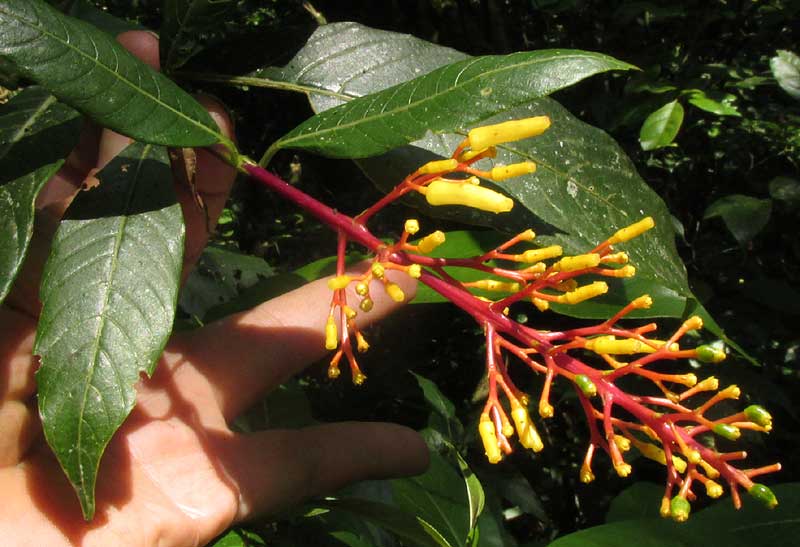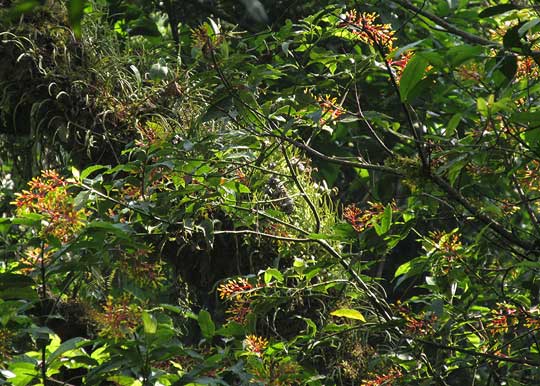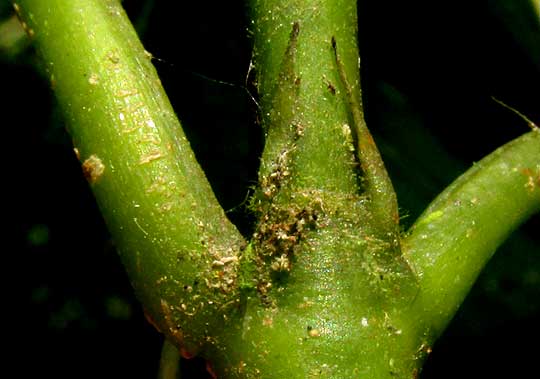Excerpts from Jim Conrad's
Naturalist Newsletter

notes from the May 10, 2015 Newsletter describing a camping trip, in the last week of April, in the hydrological reserve above San AndrésTuxtla, Veracruz, México; elevation ~1180m (5900ft), ~N18.52°, ~W95.15°
CAFECILLO
During the last week in April when I camped in the mountain-top hydrological reserve above and to the north of San Andrés Tuxtla, Veracruz, Mexico, one of the most conspicuously flowering plants in the cloud forest there was a small tree averaging maybe 15 feet tall (4.5m). Occupying the forest's understory and woods edges, the small tree's branches typically were much entangled with branches of nearby tree neighbors, as shown below:

The eye was drawn to these flowers not only because the fair-sized, brightly yellow blossoms strongly contrasted with the forest's general dark greenness, but also the inflorescence branches -- the rachis and rachillae -- were bright red, as seen at the top of this page. The trees' fruits weren't yet ripe, but often green, immature ones hinted at the eventual mature fruit's size and shape, as seen below:

In that picture the top of each fruit bears the remains of the flowers' calyxes. That means that the flowers' ovaries had been "inferior" -- produced below the calyx, unlike the majority of flowers whose ovaries develop above the calyx. When a flowering plant's flowers have inferior ovaries, the identification process is simplified since only a minority of plant families produce them.
In the American Tropics, whenever I see a woody plant bearing flowers with inferior ovaries, immediately I check to see if its leaves arise two per stem node, or opposite one another. If they do, then I see if conspicuous "stipules" are present, stipules being small, leafy appendages at the base of each leaf petiole. If the plant bears opposite leaves and conspicuous stipules, then it's a near certainty that the plant will be a member of the large Coffee or Madder Family, the Rubiaceae. Our cloud-forest tree's leaves were opposite, and at the base of each petiole arose slender, sharp-pointed, green stipules, as seen below:

Our little tree is PALICOUREA PADIFOLIA, found in middle-elevation cloud forests from southern Mexico to Panama. Because it's a small tree with opposite, shiny leaves and it produces clusters of roundish fruits, it's vaguely similar to Coffee shrubs, which belong to the same family, and often is called Cafecillo, meaning "little coffee."
The genus Palicourea, though not present in continental North America, is a big one in the American tropics, embracing about 200 species. Normally Palicourea flowers are pollinated by hummingbirds. Almost one-tenth of all Palicourea species are listed as threatened by the IUCN, even though that agency has only reviewed species occurring in Ecuador. Though our Cafecillo was common in the cloud forest above San Andrés Tuxtla, cloud forests themselves are very much endangered by human activity.
It turns out that Cafecillo, Palicourea padifolia, has been the focus of several studies, largely because its flowers are "distylous." Distylous flowers are those produced by species in which two flower types are recognizable, based on whether they have relatively long or short styles, with the two flower types occurring on separate plants. Styles are the "necks" between a flower's ovaries and their pollen-receiving stigmas. Species with distylous flowers are regarded as evolutionary transition states between species with flowers having both male and female parts, and "monoecious" species, in which male and female flowers occur on different plants. Scientists study species with distylous flowers to figure out the advantages of being monoecious, and to learn how the evolution toward the monoecious state may have occurred.